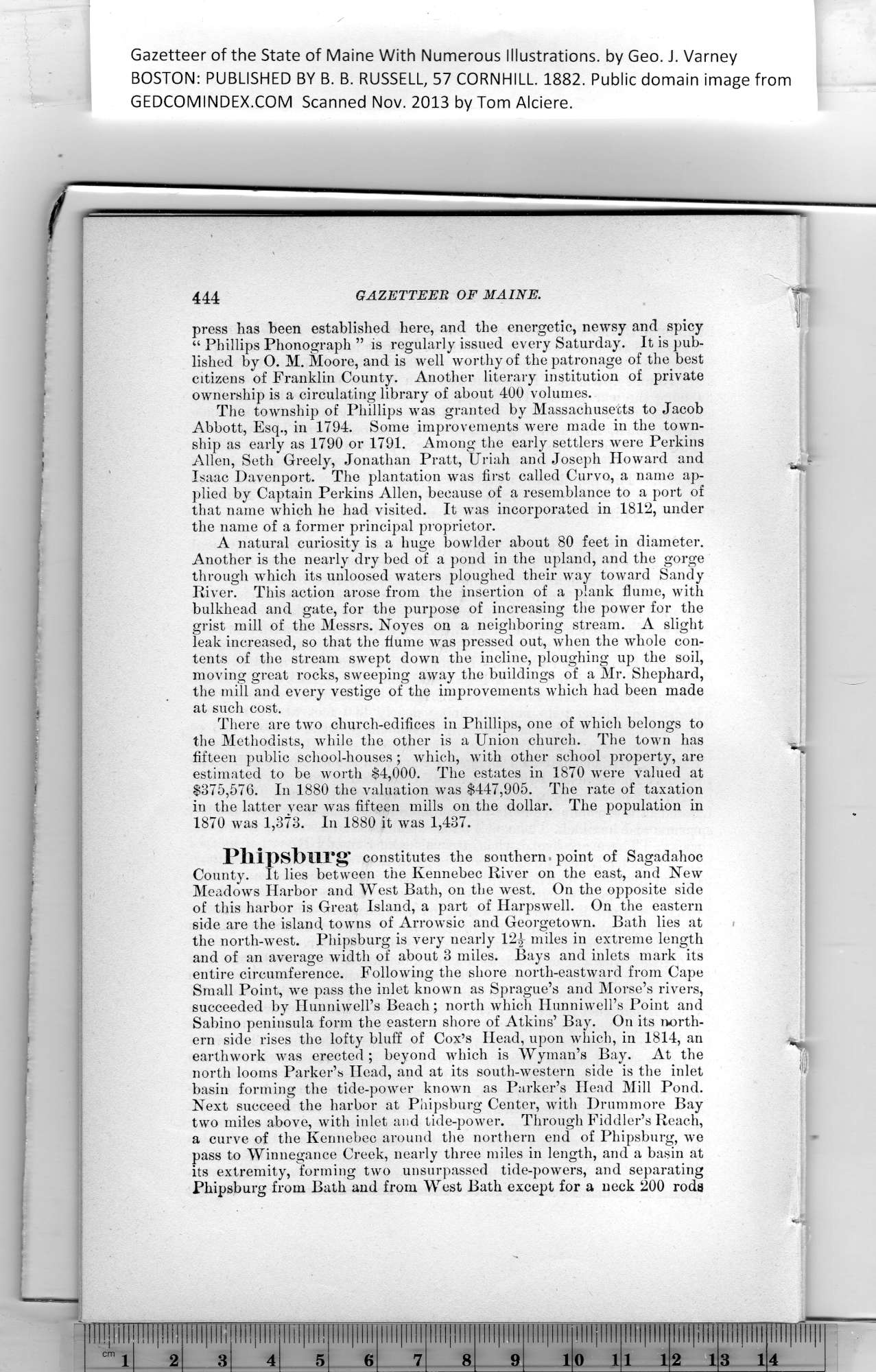|
Gazetteer of the State of Maine With Numerous Illustrations, by Geo. J. Varney
BOSTON: PUBLISHED BY B. B. RUSSELL, 57 CORNHILL. 1882. Public domain image from
444 GAZETTEER OF MAINE.
press has been established here, and the energetic, newsy and spicy
“ Phillips Phonograph ” is regularly issued every Saturday. It is pub-
lished by O. M. Moore, and is well worthy of the patronage of the best
citizens of Franklin County. Another literary institution of private
ownership is a circulating library of about 400 volumes.
The township of Phillips was granted by Massachusetts to Jacob
Abbott, Esq., in 1794. Some improvements were made in the town-
ship as early as 1790 or 1791. Among the early settlers were Perkins
Allen, Seth Greely, Jonathan Pratt, Uriah and Joseph Howard and
Isaac Davenport. The plantation was first called Curvo, a name ap-
plied by Captain Perkins Allen, because of a resemblance to a port of
that name which he had visited. It was incorporated in 1812, under
the name of a former principal proprietor.
A natural curiosity is a huge bowlder about 80 feet in diameter.
Another is the nearly dry bed of a pond in the upland, and the gorge
through which its unloosed waters ploughed their way toward Sandy
River. This action arose from the insertion of a plank flume, with
bulkhead and gate, for the purpose of increasing the power for the
grist mill of the Messrs. Noyes on a neighboring stream. A slight
leak increased, so that the flume was pressed out, when the whole con-
tents of the stream swept down tbe incline, ploughing up the soil,
moving great rocks, sweeping away the buildings of a Mr. Shephard,
the mill and every vestige of the improvements which had been made
at such cost.
There are two church-edifices in Phillips, one of which belongs to
the Methodists, while the other is a Union church. The town has
fifteen public school-houses; which, with other school property, are
estimated to be worth $4,000. The estates in 1870 were valued at
$375,576. In 1880 the valuation was $447,905. The rate of taxation
in the latter year was fifteen mills on the dollar. The population in
1870 was 1,373. In 1880 it was 1,437.
PhipsTbiirg* constitutes tbe southern, point of Sagadahoc
County. It lies between the Kennebec River on the east, and New
Meadows Harbor and West Bath, on tbe west. On the opposite side
of this harbor is Great Island, a part of Harpswell. On the eastern
side are the island towns of Arrowsic and Georgetown. Bath lies at
the north-west. Phipsburg is very nearly 12£ miles in extreme length
and of an average width of about 3 miles. Bays and inlets mark its
entire circumference. Following the shore north-eastward from Cape
Small Point, we pass tbe inlet known as Sprague’s and Morse’s rivers,
succeeded by Hunniwell’s Beach; north which Hunniwell’s Point and
Sabino peninsula form the eastern shore of Atkins’ Bay. On its north-
ern side rises the lofty bluff of Cox’s Head, upon which, in 1814, an
earthwork was erected ; beyond which is Wyman’s Bay. At tbe
north looms Parker’s Head, and at its south-western side is tbe inlet
basin forming the tide-power known as Parker’s Head Mill Pond.
Next succeed the harbor at Phipsburg Center, with Drummore Bay
two miles above, with inlet and tide-power. Through Fiddler’s Reach,
a curve of the Kennebec around the northern end of Phipsburg, we
pass to Winnegance Creek, nearly three miles in length, and a basin at
its extremity, forming two unsurpassed tide-powers, and separating
Phipsburg from Bath and from West Bath except for a neck 200 rods
PREVIOUS PAGE ... NEXT PAGE
This page was written in HTML using a program written in Python 3.2
|
